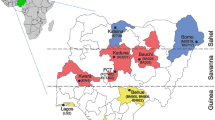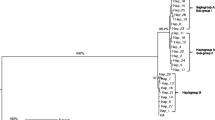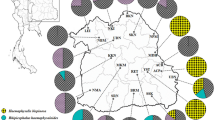Abstract
The closely related species Rhipicephalus appendiculatus and R. zambeziensis co-occur in a wide area in Zambia. In this area, specimens of both species have been collected on the same individual host at the same time. In addition, specimens that are morphologically intermediate between R. appendiculatus and R. zambeziensis have been found in this area. These observations cast some doubt on the species status of R. appendiculatus and R. zambeziensis. Because the two taxa have varied influences on the epidemiology of East Coast fever (ECF), a cattle disease for which they act as vectors, it is essential that their taxonomic status is clarified and their identification is accurate. Therefore a phylogenetic analysis of nucleotide sequences of the ITS2 and a fragment of the mitochondrial 12S rDNA was performed to reassess the specific status of both taxa. This revealed two well supported clades coinciding with R. appendiculatus and R. zambeziensis as two separate species. In order to facilitate species identification a PCR-RFLP diagnostic assay was developed based on BauI digestion of the ITS2 gene. This assay produced clear diagnostic banding patterns for the two species and is applicable over a wide range of both species’ distribution.


Similar content being viewed by others
References
Avise JC (2000) Phylogeography: the history and formation of species. Harvard University Press, Cambridge and London
Barker SC (1998) Distinguishing species and populations of Rhipicephaline ticks with ITS2 ribosomal RNA. J Parasitol 84:887–892
Beati L, Keirans JE (2001) Analysis of the systematic relationships among ticks of the genera Rhipicephalus and Boophilus (Acari: Ixodidae) based on the mitochondrial 12S ribosomal DNA gene sequences and morphological characters. J Parasitol 87:32–48
Berkvens DL, Geysen DM, Chaka G, Madder M, Brandt JRA (1998) A survey of the Ixodid ticks parasitizing cattle in the Eastern Province of Zambia. Med Vet Entomol 12:234–240
Berkvens DL, Pegram RG, Brandt JRA (1995) A study of the diapausing behaviour of Rhipicephalus appendiculatus and R. zambeziensis under quasi-natural conditions in Zambia. Med Vet Entomol 9:307–315
Berkvens N (2002) Differentiatie van teken van het Rhipicephalus appendiculatus/R. zambeziensis complex uit Zambia. Scriptie voorgedragen tot het behalen van de graad van Bio-ingenieur in de Landbouw, Ghent University, academiejaar 2001–2002
Boom R, Sol C, Beld M, Weel J, Goudsmit J, Wertheim-van Dillen PME (1999) Improved silica-guanidiniumthiocyanate DNA isolation procedure based on selective binding of bovine alpha-casein to silica particles. J Clin Microbiol 37:615–619
Boom R, Sol CJA, Salimans MMM, Jansen CL, Wertheim-van Dillen PME, Van Der Noordaa J (1990) Rapid and simple method of purification of nucleic acids. J Clin Microbiol 28:495–503
Chaka G, Billiouw M, Geysen DM, Berkvens DL (1999) Spatial and temporal variation in Rhipicephalus appendiculatus size in eastern Zambia. Trop Med Int Health 4:A43–A48
Domanico MJ, Phillips RB, Oakley TH (1997) Phylogenetic analysis of Pacific salmon (genus Oncorhynchus) using nuclear and mitochondrial DNA sequences. Can J Fish Aquat Sci 54:1865–1872
Madder M, Speybroeck N, Bilounga A, Helleputte D, Berkvens D (2005) Survival of unfed Rhipicephalus appendiculatus and Rhipicephalus zambeziensis adults. Med Vet Entomol 19:245–250
Madder M, Speybroeck N, Brandt J, Tirry L, Hodek I, Berkvens D (2002) Geographic variation in diapause response of adult Rhipicephalus appendiculatus ticks. Exp Appl Acarol 27:209–221
Madder M, Speybroeck N, Brandt J, Berkvens D (1999) Diapause induction in adults of three Rhipicephalus appendiculatus stocks. Exp Appl Acarol 23:961–968
Mayden RL (1997) A hierarchy of species concepts: the denouement in the saga of the species problem. In: Claridge MF, Dawah HA, Wilson MR (eds) Species: the units of biodiversity. Chapman and Hall, London, pp 382–425
Mtambo J, Van Bortel W, Madder M, Roelants P, Backeljau T (2006) Comparison of preservation methods of Rhipicephalus appendiculatus (Acari: Ixodidae) for reliable DNA amplification by PCR. Exp Appl Acarol 38:189–199
Murrell A, Campbell NJH, Barker SC (2001) A total-evidence phylogeny of ticks provides insights into the evolution of life cycles and biogeography. Mol Phylogenet Evol 21:244–258
Mulumba M (1999) Epidemiology of Theileria parva theileriosis in the Southern province of Zambia. PhD thesis, Institute of Tropical Medicine, Antwerp, Belgium, 158 pp
Nicholas KB, Nicholas HB Jr (1997) GeneDoc: a tool for editing and annotating multiple sequence alignments. Distributed by author. http://www.psc.edu/biomed/genedoc/gddl.htm
Norval RAI, Perry BD, Young AS (1992) The epidemiology of theileriosis in Africa. Academic Press, London, 99 pp
Nuttall GHF (1913–1914) Rhipicephalus appendiculatus: variation in size and structure due to nutrition. Parasitology 6:195–204
Pegram RG, Banda DS (1990) Ecology and phenology of the cattle ticks in Zambia: development and survival of free-living stages. Exp Appl Acarol 9:291–301
Posada D, Crandall KA (1998) Modeltest: testing the model of DNA substitution. Bioinformatics 14:817–818
Ronquist F, Huelsenbeck JP (2003) MRBAYES: Bayesian phylogenies under mixed models. Bioinformatics 19:1572–1574
Simon C, Frati F, Beckenbach A, Crespi B, Liu H, Flook P (1994) Evolution, weighting and phylogenetic utility of mitochondrial gene sequences and a compilation of conserved polymerase chain reaction primers. Ann Entomol Soc Am 87:651–701
Speybroeck N, Madder M, Van Den Bossche P, Mtambo J, Berkvens N, Chaka G, Mulumba M, Brandt J, Tirry L, Berkvens D (2002) Distribution and phenology of ixodid ticks in Southern Zambia. Med Vet Entomol 16:430–441
Swofford DL (2003) PAUP* Phylogenetic analysis using parsimony (*and other methods). Sinauer Associates, Sunderland, Massachusetts
Thompson JD, Gibson TJ, Plewniak F, Jeanmougin F, Higgins DG (1997) The ClustalX windows interface: flexible strategies for multiple sequence alignment aided by quality analysis tools. Nucleic Acids Res 25:4876–4882
Walker JB, Keirans JE, Horak IG (2000) The genus Rhipicephalus (Acari: Ixodidae): a guide to the brown ticks of the world. Cambridge University Press, Cambridge
Walker JB, Norval RAI, Corwin MD (1981) Rhipicephalus zambeziensis sp. nov., a new tick from eastern and southern Africa, together with a redescription of Rhipicephalus appendiculatus Neumann, 1901 (Acarina, Ixodidae). Onderstepoort. J Vet Res 48:87–104
Wouters G, Brandt J, Berkvens D (1987) Species characterization of Rhipicephalus appendiculatus and Rhipicephalus zambeziensis (Ixodidae: Acarina) by enzyme-electrophoresis. Ann Soc België Med Trop 67:267–270
Zivkovic D, Pegram RG, Jongejan F, Mwase ET (1986) The biology of Rhipicephalus appendiculatus and R. zambeziensis and production of a fertile hybrid under laboratory conditions. Exp Appl Acarol 2:285–298
Acknowledgements
We are grateful to the technical staff in Eastern and Southern provinces of Zambia for their help in tick collections. Special thanks to Pim De Rijk and Ko De Witte of ITMA for their invariable technical advice. H. Van Paesschen (RBINS) kindly prepared the artwork. Drs T. Marcotty and R. De Deken kindly collected the R. appendiculatus specimens from Hluhuwe, South Africa and Grande Comore, respectively. This study was made possible by funding from the Belgian Technical Co-operation (BTC) through the Assistance to Veterinary Services of Zambia (ASVEZA) project.
Author information
Authors and Affiliations
Corresponding author
Additional information
Nucleotide sequence data reported in this paper are available in the GenBank™ under the accession numbers DQ849203–DQ849274.
Rights and permissions
About this article
Cite this article
Mtambo, J., Madder, M., Van Bortel, W. et al. Rhipicephalus appendiculatus and R. zambeziensis (Acari: Ixodidae) from Zambia: a molecular reassessment of their species status and identification. Exp Appl Acarol 41, 115–128 (2007). https://doi.org/10.1007/s10493-006-9037-y
Received:
Accepted:
Published:
Issue Date:
DOI: https://doi.org/10.1007/s10493-006-9037-y




